How familiar are you with the 17 SDGs?
Knowing the 17 set goals is the foundation and blueprint to achieve a better and sustainable future. Not all 17 of the SDGs are equally relevant for you and your business, but knowing them all is important in order to know and minimize your negative impact as a whole. Learn – or refresh your memory – about what the goals are and why they matter below!
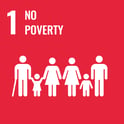 1. No Poverty. End poverty in all its forms everywhere.
1. No Poverty. End poverty in all its forms everywhere.
Sustainable Development Goal 1 (SDG1) aims to end poverty in all its forms everywhere. Extreme poverty has in many cases resulted in many severe problems, such as social exclusion, diseases, instability and conflicts. High poverty rates are most often found in conflict-ridden regions, and children are disproportionately affected. One out of five children currently live in extreme poverty. Therefore, ensuring social protection for vulnerable groups, such as children and new mothers, is critical to reduce poverty.
The UN explains, “more than 700 million people, or 10% of the world population, still live in extreme poverty and are struggling to fulfill the most basic needs like health, education, and access to water and sanitation… The majority of people living on less than 1.90 USD a day live in sub-Saharan Africa. Worldwide, the poverty rate in rural areas is 17.2%—more than three times higher than in urban areas.“
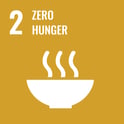 2. Zero Hunger
2. Zero Hunger
SDG2 aims to end hunger, achieve food security and improve nutrition and promote sustainable agriculture.
There are over 821 million who are hungry today and it is expected to increase by an additional two billion by 2050. We are in need of profound changes of today's global food and agriculture systems, as climate change is degrading our soils, freshwater, biodiversity, forests and oceans. This creates severe risks, such as droughts and floods, that affect the resources we depend on to sustain life.
The UN explains: “It is time to rethink how we grow, share and consume our food. If done right, agriculture, forestry and fisheries can provide nutritious food for all and generate decent incomes, while supporting people-centered rural development and protecting the environment.”
 3. Good Health and well-being
3. Good Health and well-being
SDG3 aims to ensure healthy lives and promote well-being for all at all ages by 2030. Child health, maternal health, malaria and other diseases are all important topics to consider when ensuring good health and wellbeing. There have been significant breakthroughs that have increased life expectancy and made it possible to treat deadly diseases. However, there is still comprehensive and progressive work to do. 17,000 fewer children die annually compared to 1990, but there are still more than five million children that die before the age of five. Maternal mortality has decreased with 37% since 2000, but women in developing regions are 14 times more likely to die during childbirth compared to those in developed regions. Through the use of more efficient technologies, implementing health care systems, using clean fossil fuels, and increased use knowledge in reducing ambient pollution are some strategies that can help save millions of lives.
>The UN explains: “Ensuring healthy lives and promoting well-being at all ages is essential to sustainable development.”
 4. Quality Education.
4. Quality Education.
SDG4 aims to ensure inclusive and quality education for all and promote lifelong learning. There has been major progress in the last decade in getting more people enrolled in schools, education for girls and women, and increasing access to education for everyone globally. Even still, there are over 265 million children out of school and even those that do attend lack basic reading and math skills. The lack of quality education is due to unqualified teachers, poor school conditions, and limited opportunities for children living in rural areas. Achieving this target requires more investment in educational scholarships, better infrastructure of school buildings, and improved teaching training workshops.
The UN explains: “Obtaining a quality education is the foundation to creating sustainable development. In addition to improving quality of life, access to inclusive education can help equip locals with the tools required to develop innovative solutions to the world’s greatest problems.”
 5. Gender Equality.
5. Gender Equality.
SDG5 aims to achieve gender equality and empower all women and girls.
While gender equality, women’s empowerment, and equal access to primary education between girls and boys has progressively improved during the Millenium Development Goals (MDGs), women and girls still suffer from severe violence and discrimination worldwide.Currently, 49 countries lack laws that protect women from domestic violence, which affects at least 1 in 5 women and girls between the ages of 15 - 49.
The UN explains: “Providing women and girls with equal access to education, health care, decent work, and representation in political and economic decision-making processes ... the eradication of harmful practices targeted at women is crucial to ending the gender-based discrimination prevalent in many countries around the world.”
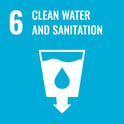 6. Clean Water and Sanitation
6. Clean Water and Sanitation
SDG6 aims to ensure access to water and sanitation for all. Right now, more than 2 billion people are living with the risk of reduced access to freshwater resources and by 2050, and at least one in four people are likely to live in a country affected by chronic or recurring shortages of fresh water. Drought in specific afflicts some of the world’s poorest countries, worsening hunger and malnutrition. To improve sanitation and access to drinking water, there needs to be increased investment in management of freshwater ecosystems and sanitation facilities.
The UN explains: “Clean, accessible water for all is an essential part of the world we want to live in and there is sufficient fresh water on the planet to achieve this. However, due to bad economics or poor infrastructure, millions of people including children die every year from diseases associated with inadequate water supply, sanitation and hygiene.”
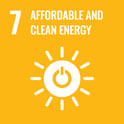 7. Affordable and Clean Energy.
7. Affordable and Clean Energy.
SDG7 aims to Ensure access to affordable, reliable, sustainable and modern energy for all. Energy is essential for the majority of challenges and opportunities in today’s modern society, such as global health care, increasing income, and agriculture. However, the use of electricity is primarily dependent on the use of fossil fuel and these sources won’t last forever. Scientists estimate that the world has consumed around 40% of all oil, and if consumption continues at the same rate, will run dry in 50 years. Measures have already been taken, but the challenge is far from being solved. Everyone should have access to clean fuel, and we need to integrate renewable energy in buildings, transportation, and the industrial sector.
The UN explains: “Energy is central to nearly every major challenge and opportunity the world faces today...Working towards this goal is especially important as it interlinks with other Sustainable Development Goals. Focusing on universal access to energy, increased energy efficiency and the increased use of renewable energy through new economic and job opportunities is crucial to creating more sustainable and inclusive communities and resilience to environmental issues like climate change.”
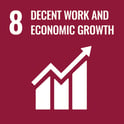 8. Decent Work and Economic Growth
8. Decent Work and Economic Growth
SDG8 aims to Promote inclusive and sustainable economic growth, employment and decent work for all. Labor productivity is decreasing and there is a continued lack of decent work opportunities, which causes unemployment rates to rise. In turn, standards of living decline due to lower income. Achieving sustainable economic growth requires an economy that creates quality jobs and simultaneously does not harm the environment. Increasing Access to financial services, productive investments commitments to trade, banking, agriculture and infrastructure will create productivity and help reduce unemployment, notably in the most affected areas.
The UN explains: “Roughly half the world’s population still lives on the equivalent of about 2 USD a day with global unemployment rates of 5.7% and having a job doesn’t guarantee the ability to escape from poverty in many places. This slow and uneven progress requires us to rethink and retool our economic and social policies aimed at eradicating poverty.”
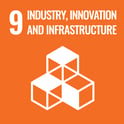 9. Industry, Innovation and Infrastructure
9. Industry, Innovation and Infrastructure
SDG9 aims to Build resilient infrastructure, promote sustainable industrialization and foster innovation. Investing in infrastructure, such as transport, energy, and communication technology, generates growth in productivity and increases income, quality education and health. Achieving a sustainable world for all is therefore strongly dependent on empowering communities in many countries without harming the environment.
The UN explains: “Without technology and innovation, industrialization will not happen, and without industrialization, development will not happen. There needs to be more investments in high-tech products that dominate the manufacturing productions to increase efficiency and a focus on mobile cellular services that increase connections between people.”
 10. Reduced Inequalities
10. Reduced Inequalities
SDG10 aims to reduce inequality within and among countries. Rather than seeing a reduction of inequality in recent decades, inequality has increased nearly everywhere. It is lowest in Europe and highest in the Middle East. This goal strives to break this trend and promote economic inclusion regardless of gender, ethnicity, or race.
The UN explains: “The international community has made significant strides towards lifting people out of poverty. The most vulnerable nations – the least developed countries, the landlocked developing countries and the small island developing states – continue to make inroads into poverty reduction. However, inequality persists and large disparities remain regarding access to health and education services and other assets.”
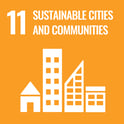 11. Sustainable Cities and Communities
11. Sustainable Cities and Communities
SDG11 aims to make cities inclusive, safe, resilient and sustainable. The world faces many challenges as urbanization rapidly extends. A huge challenge lies in creating jobs and welfare without jeopardizing our planet’s resources. In order to secure sustainability in urban areas, improving safe management and use of resources, as well as reducing pollution and poverty is necessary.
The UN explains: “Cities are hubs for ideas, commerce, culture, science, productivity, social development and much more. At their best, cities have enabled people to advance socially and economically. With the number of people living within cities projected to rise to 5 billion people by 2030, it’s important that efficient urban planning and management practices are in place to deal with the challenges brought by urbanization.”
 12. Responsible Consumption and Production
12. Responsible Consumption and Production
SDG12 aims to ensure sustainable consumption and production patterns.
A large part of the population is still consuming far too little to meet basic needs, while ⅓ of all food produced - equivalent to 1.3 billion tons worth ~ 1 trillion USD - is going to waste. In order to integrate sustainable consumption and production processes,it is necessary to decrease resource usage, address challenges regarding pollution, and provide access to basic services for all. UN also highlights the importance of value chain transparency: “There also needs to be significant focus on operating on value chain, involving everyone from producer to final consumer.”
The UN explains: “Sustainable consumption and production is about promoting resource and energy efficiency, sustainable infrastructure, and providing access to basic services, green and decent jobs and a better quality of life for all. Its implementation helps to achieve overall development plans, reduce future economic, environmental and social costs, strengthen economic competitiveness and reduce poverty."
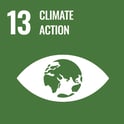 13. Climate Action
13. Climate Action
SDG13 aims to take urgent action to combat climate change and its impact.
Every country, business, and individual is affected by consequences related to climate change, some more severely than others. 91% of geophysical disasters are climate-related, where millions have been killed and billions affected. Hundreds of billions of USD are lost annually because of climate-related disasters. The issues of climate change reach far beyond national borders, and this issue is therefore strongly dependent on global alliance between nations and stakeholders.
The UN explains: “Weather patterns are changing, sea levels are rising, weather events are becoming more extreme and greenhouse gas emissions are now at their highest levels in history. Without action, the world’s average surface temperature is likely to surpass 3 degrees centigrade this century. The poorest and most vulnerable people are being affected the most.”
 14. Life below Water
14. Life below Water
SDG 14aims to conserve and sustainably use oceans, seas, and marine resources.
Sustainably managing the planet’s water is essential in order to protect its ecosystem and thus preserve biodiversity and fundamental human resources. In order to achieve this goal, marine areas need to be effectively managed, regulated and protected, and tackle challenges such as overfishing, marine pollution and ocean acidification.
The UN explains: “The world’s oceans – their temperature, chemistry, currents and life – drive global systems that make the Earth habitable for humankind. Our rainwater, drinking water, weather, climate, coastlines, much of our food, and even the oxygen in the air we breathe, are all ultimately provided and regulated by the sea. Throughout history, oceans and seas have been vital conduits for trade and transportation!”
 15. Life on Land
15. Life on Land
SDG15 aims to Sustainably manage forests, combat desertification, halt and reverse land degradation, halt biodiversity loss.
Land is an equally important resource for humans as the oceans as 80% of the human diet is plant life and agriculture is considered an important economic resource. However, the maintenance of these resources requires urgent change. Currently, 13 million hectares of forest are annually being lost and wildlife trafficking erodes biodiversity, creates insecurity, and feeds corruption and conflicts.
The UN explains: “Forests cover 30.7% of the Earth’s surface and, in addition to providing food security and shelter, they are key to combating climate change, protecting biodiversity and the homes of the indigenous population. By protecting forests, we will also be able to strengthen natural resource management and increase land productivity.”
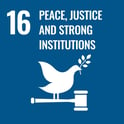 16. Peace and Justice Strong Institutions
16. Peace and Justice Strong Institutions
SDG16 aims to promote just, peaceful and inclusive societies.
Sustainable development can never be reached without working to achieve effective governance, peace, sustainability and human rights for everyone. Unfortunately there is a child killed by violence every minutes somewhere in the world, and child online sexual abuse reports to National Center for Missing and Exploited children (NCMEC) has increased from 1 million in 2014 to 45 million in 2018. Institutions are being affected by corruption mostly in the judiciary system and police force. Corruption, bribery, theft, and tax evasion costs amount to approximately 1.26 USD trillion in developing countries per year. Implementation of comprehensive, realistic government budgets and more independent national human rights institutions would be a step in the right direction
The UN explains: “The threats of international homicide, violence against children, human trafficking and sexual violence are important to address to promote peaceful and inclusive societies for sustainable development. They pave the way for the provision of access to justice for all and for building effective, accountable institutions at all levels.”
 17. Partnership for the Goals
17. Partnership for the Goals
SDG17 aims to Revitalize the global partnership for sustainable development.
Achieving the SDGs is dependent on a strong, global partnership and cooperation. Action beyond national borders is the most effective way to mobilize, redirect, and unlock the transformative economic power of trillions of USD of private resources and deliver on the sustainable development objectives.
The UN explains: “A successful sustainable development agenda requires partnerships between governments, the private sector and civil society. These inclusive partnerships built upon principles and values, a shared vision, and shared goals that place people and the planet at the center, are needed at the global, regional, national and local level."



 1. No Poverty. End poverty in all its forms everywhere.
1. No Poverty. End poverty in all its forms everywhere.
 3. Good Health and well-being
3. Good Health and well-being












